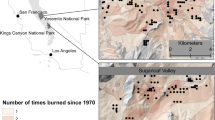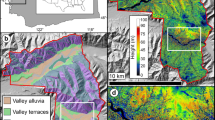Abstract
Isolated forested mountains in deserts have numerous ecological and societal values, but land-management practices (e.g., fire-regime alteration) and climate change can affect forest composition. We analyzed tree overstory-understory relationships on 123 sites in the Spring Mountains within the Mojave Desert near Las Vegas, Nevada, USA to assess three hypotheses. We hypothesized that: the tree species comprising understories are less tolerant of fire than species in overstories, reflecting land-management practices of fire exclusion; mid-elevation forests have the lowest overstory:understory similarity because this zone could have maximum species mixing; and overstory:understory similarity is correlated with environmental gradients (consisting of 14 topographic and soil variables). We found that Pinus monophylla comprised greater relative canopy cover in understories of juniper (32% relative cover) and pinyon-juniper (78%) forests than it did in overstories of these forests (0% and 53%). Similarly, fire-intolerant Abies concolor had 6-fold greater understory than overstory cover in forests with overstories dominated by the fire-tolerant Pinus ponderosa. Overstory:understory Sørensen similarity averaged 43%−77% among six forest types, and there was little support for the supposition that similarity was lowest in mid-elevation forests. Distributions of individual overstory and understory species more closely corresponded with environmental gradients than did overstory:understory similarity. Results suggest that there is high potential for change in at least two of the six dominant forest types of the Spring Mountains. The direction of change (species of moist, higher elevation sites establishing in understories of drier forests) is the opposite of what would be expected for forest adaptation to the warmer, drier, more fire-prone conditions projected for the next century in the southwestern USA.




Similar content being viewed by others
References
Barbour M, Kelley E, Maloney P, Rizzo D, Royce E, Fites-Kaufmann J (2002) Present and past old-growth forests of the Lake Tahoe Basin, Sierra Nevada, US. J Veg Sci 13:461–472
Bässler C, Müller J, Dziock F (2010) Detection of climate-sensitive zones and identification of climate change indicators: a case study from the Bavarian Forest National Park. Folia Geobot 45:163–182
Beers TW, Dress PE, Wensel LC (1966) Aspect transformation in site productivity research. J Forest 64:691–692
Breiman L, Friedman JH, Olshen RA, Stone CJ (1984) Classification and regression trees. Wadsworth, Inc., Belmont, CA
Burns RM, Honkala BH (1990) Silvics of North America. Volume 1: conifers. Agriculture Handbook 654. U.S. Department of Agriculture, Forest Service, Washington, D.C.
Clokey IW (1951) Flora of the Charleston Mountains, Clark County, Nevada. University of California Press, Berkeley, CA
Cocke AE, Fulé PZ, Crouse JE (2005) Forest change on a steep mountain gradient after extended fire exclusion: San Francisco Peaks, Arizona, USA. J Appl Ecol 42:814–823
Covington WW, Everett RL, Steele R, Irwin LL, Daer TA, Auclair AND (1994) Historical and anticipated changes in forest ecosystems of the inland west of the United States. J Sustain Forest 2:13–63
Fulé PZ, Laughlin DC (2007) Wildland fire effects on forest structure over an altitudinal gradient, Grand Canyon National Park, USA. J Appl Ecol 44:136–146
Fulé PZ, Korb JE, Wu R (2009) Changes in forest structure of a mixed conifer forest, southwestern Colorado, USA. Forest Ecol Managem 258:1200–1210
Gill SJ, Biging GS, Murphy EC (2000) Modeling conifer tree crown radius and estimating canopy cover. Forest Ecol Managem 126:405–416
Gutsell SL, Johnson EA (1996) How fire scars are formed: coupling a disturbance process to its ecological effect. Canad J Forest Res 26:166–174
Hille Ris Lambers J, Clark JS (2003) Effects of dispersal, shrubs, and density-dependent mortality on seed and seedling distributions in temperate forests. Canad J Forest Res 33:783–795
Huffman DW, Fulé PZ, Pearson KM, Crouse JE (2008) Fire history of pinyon-juniper woodlands at upper ecotones with ponderosa pine forests in Arizona and New Mexico. Canad J Forest Res 38:2097–2108
Hulme PE (2005) Adapting to climate change: is there scope for ecological management in the face of a global threat? J Appl Ecol 42:784–794
Johnson DD, Miller RF (2006) Structure and development of expanding western juniper woodlands as influenced by two topographic variables. Forest Ecol Managem 229:7–15
Lato LJ (2006) Soil survey of Clark County area, Nevada. U.S. Department of Agriculture, Natural Resources Conservation Service, U.S. Government Printing Office, Washington, D.C.
McCune B (2006) Non-parametric habitat models with automatic interactions. J Veg Sci 17:819–830
McCune B (2007) Improved estimates of incident radiation and heat load using non-parametric regression against topographic variables. J Veg Sci 18:751–754
McCune B, Mefford MJ (1999) PC-ORD: multivariate analysis of ecological data. Vers 4. User’s guide. MjM Software Design, Gleneden Beach, OR
McCune B, Mefford MJ (2004) Hyperniche. Multiplicative habitat modeling. Version 1.0. MjM Software, Gleneden Beach, OR
McGarigal K, Cushman S, Stafford S (2000) Multivariate statistics for wildlife and ecology research. Springer-Verlag, New York
Merkle J (1962) Plant communities of the Grand Canyon area, Arizona. Ecology 43:698–711
Millar CI, Brubaker LB (2006) Climate change and paleoecology: new contexts for restoration ecology. In Palmer MD, Falk DA, Zedler J (eds) Restoration science. Island Press, Washington, D.C., pp 315–340
Mueller-Dombois D, Ellenberg H (1974) Aims and methods of vegetation ecology. John Wiley & Sons, New York
Niles WE, Leary PJ (2007) Annotated checklist of the vascular plants of the Spring Mountains, Clark and Nye Counties, Nevada. Mentzelia 8:1–72
NRCS [Natural Resources Conservation Service] (2010) The PLANTS database. National Plant Data Center, Baton Rouge, LA, USA. Available at: http://plants.usda.gov (accessed 25 May 2010)
NWCC [National Water and Climate Center] (2010) SNOTEL and SCAN data climate monitoring. Natural Resources Conservation Service, Portland, OR, USA. Available at: http://www.wcc.nrcs.usda.gov (accessed 15 June 2010)
Oliver CD, Larson BC (1996) Forest stand dynamics. John Wiley & Sons, Inc., New York
Salzer MW, Hughes MK, Bunn AG, Kipfmueller KF (2009) Recent unprecedented tree-ring growth in bristlecone pine at the highest elevations and possible causes. Proc Natl Acad Sci USA 106:20348–20353
SAS Institute (1999) SAS/STAT user’s guide. Vers 8. SAS Institute, Inc., Cary, NC
SAS Institute (2004) JMP user’s guide. SAS Institute, Inc., Cary, NC
Seager R, Ting MF, Held IM, Kushnir Y, Lu J, Vecchi G, Huang H, Harnik N, Leetmaa A, Lau N, Li C, Velez J, Naik N (2007) Model projections of an imminent transition to a more arid climate in southwestern North America. Science 316:1181–1184
Seastedt TR, Hobbs RJ, Suding KN (2008) Management of novel ecosystems: are novel approaches required? Frontiers Ecol Environm 6:547–553
Soil Survey Staff (1993) Soil survey manual. U.S. Department of Agriculture Handbook No. 18. U.S. Government Printing Office, Washington, D.C.
Swetnam TW, Baisan CH (1996) Historical fire regime patterns in the southwestern United States since AD 1700. In Allen CD (tech ed) Fire effects in southwestern forests: proceedings of the second La Mesa Fire symposium. General Technical Report RM-GTR-286, U.S. Department of Agriculture, Forest Service, Rocky Mountain Forest and Range Experiment Station, Fort Collins, CO, pp 11–32
Urban DL, Miller C, Stephenson NL, Halpin PN (2000) Forest pattern in Sierran landscapes: the physical template. Landscape Ecol 15:603–620
Winthers E, Fallon D, Haglund J, DeMeo T, Nowacki G, Tart D, Ferwerda M, Robertson G, Gallegos A, Rorick A, Cleland DT, Robbie W (2005) Terrestrial ecological unit inventory technical guide: landscape and land unit scales. General Technical Report WO-68, U.S. Department of Agriculture, Forest Service, Washington Office, Washington, D.C.
Zimmerman GM, Goetz H, Mielke PW (1985) Use of an improved statistical method for group comparisons to study effects of prairie fire. Ecology 66:606–611
Acknowledgements
Data were provided for analysis by the U.S. Forest Service. Sharon Altman (University of Nevada Las Vegas) formatted Figs. 2 , 3 and 4 and Milind Bunyan and Sharon Altman created Fig. 1 . Wally Covington and the Ecological Restoration Institute at Northern Arizona University funded the analysis and writing. Associate Editor Laco Mucina and two anonymous reviewers provided helpful comments on the manuscript.
Author information
Authors and Affiliations
Corresponding author
Rights and permissions
About this article
Cite this article
Abella, S.R., Hurja, J.C., Merkler, D.J. et al. Overstory-Understory Relationships along Forest Type and Environmental Gradients in the Spring Mountains of Southern Nevada, USA. Folia Geobot 47, 119–134 (2012). https://doi.org/10.1007/s12224-011-9108-7
Received:
Revised:
Accepted:
Published:
Issue Date:
DOI: https://doi.org/10.1007/s12224-011-9108-7




